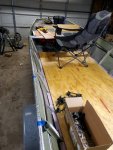bplayer405
Well-known member
- Messages
- 211
- Good Post Points
- 55
Now that it's started, I could do that. Thanks for the insight. I could switch back to the foot pedal also and lose the pulse I use with the finger switch. I feel that's part of my contamination issues from not getting hot enough.The first thing I would have to build is a boat rotator. to hold the boat on its side. No way could I bend over the gunnels or kneel inside to get all that welded. I can almost feel your pain for this project.
Aluminum welding is much faster if you have a remote so you can hammer it to start then back off as it heats up and back way off at the end to keep the crater cracks from forming. You can do it with constant current but it takes a long time to get it hot enough to flow and you really have to watch it to keep from soaking in a bead to the back side or worst case blowing a big hole.Fillets have been giving me fits. I've been starting too cold and forcing them which gives me nasty, contaminated welds. Trying to add filler too early. They take heat, but appropriate heat. There's 6 fillet welds on either side of the floor joists on each floor rib. I've went from nasty to clean just waiting on the puddle to start good and take filler. Either 5356 or 4043 work fine for me now. Talk about a revelation. I may actually get good at this sometime... lol
Yeah, that's my issue when I'm inside the boat working, can't use the pedal to control amperage. Just a finger trigger running pulse. It's a balancing act waiting on a puddle to getting things going without too much heat and blowing through and using the filler to help cool the puddle.Aluminum welding is much faster if you have a remote so you can hammer it to start then back off as it heats up and back way off at the end to keep the crater cracks from forming. You can do it with constant current but it takes a long time to get it hot enough to flow and you really have to watch it to keep from soaking in a bead to the back side or worst case blowing a big hole.



For sure, but just think of the invaluable 'on the job' training he got.Man, you could have bought a nice bass boat for what you have in that repair


